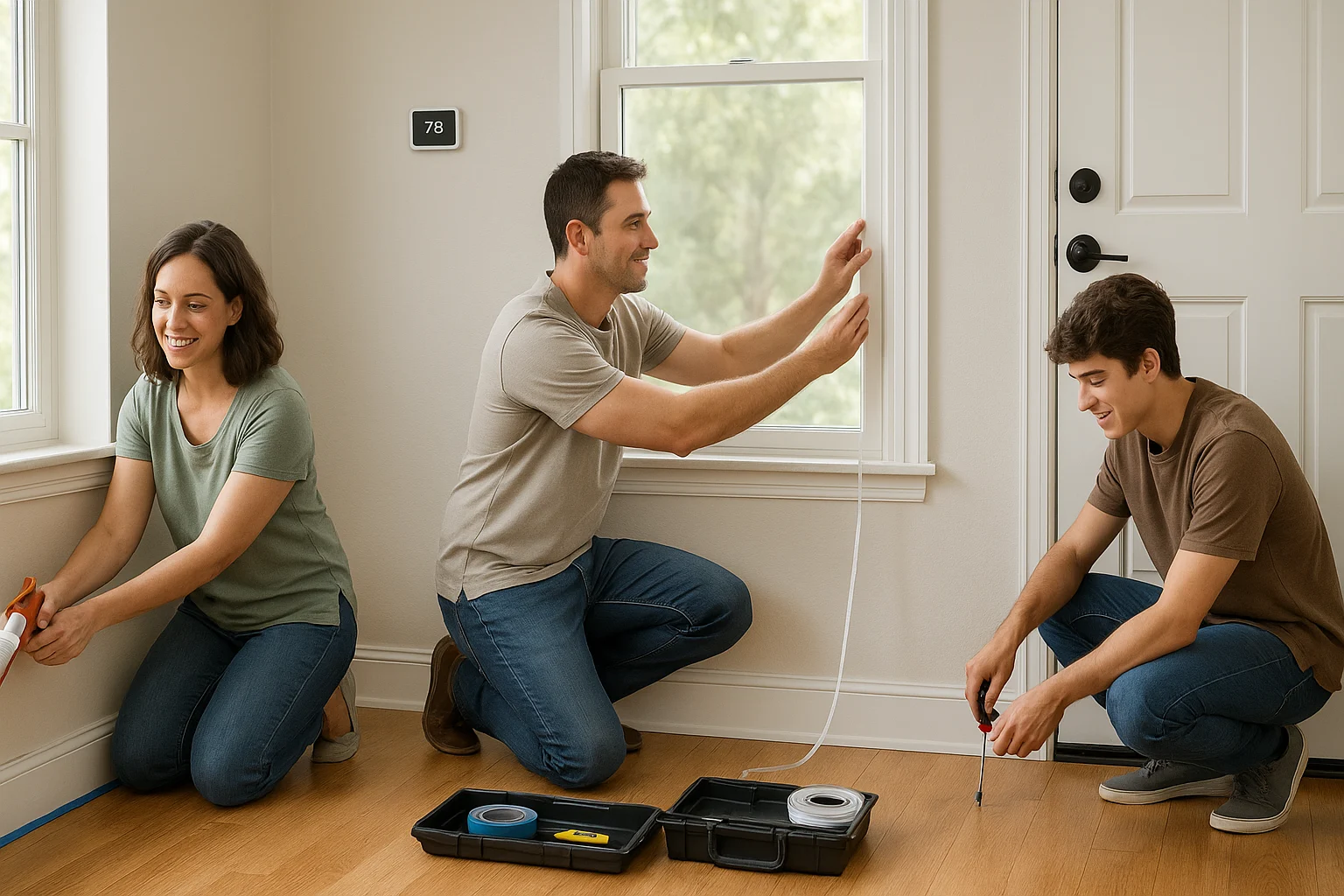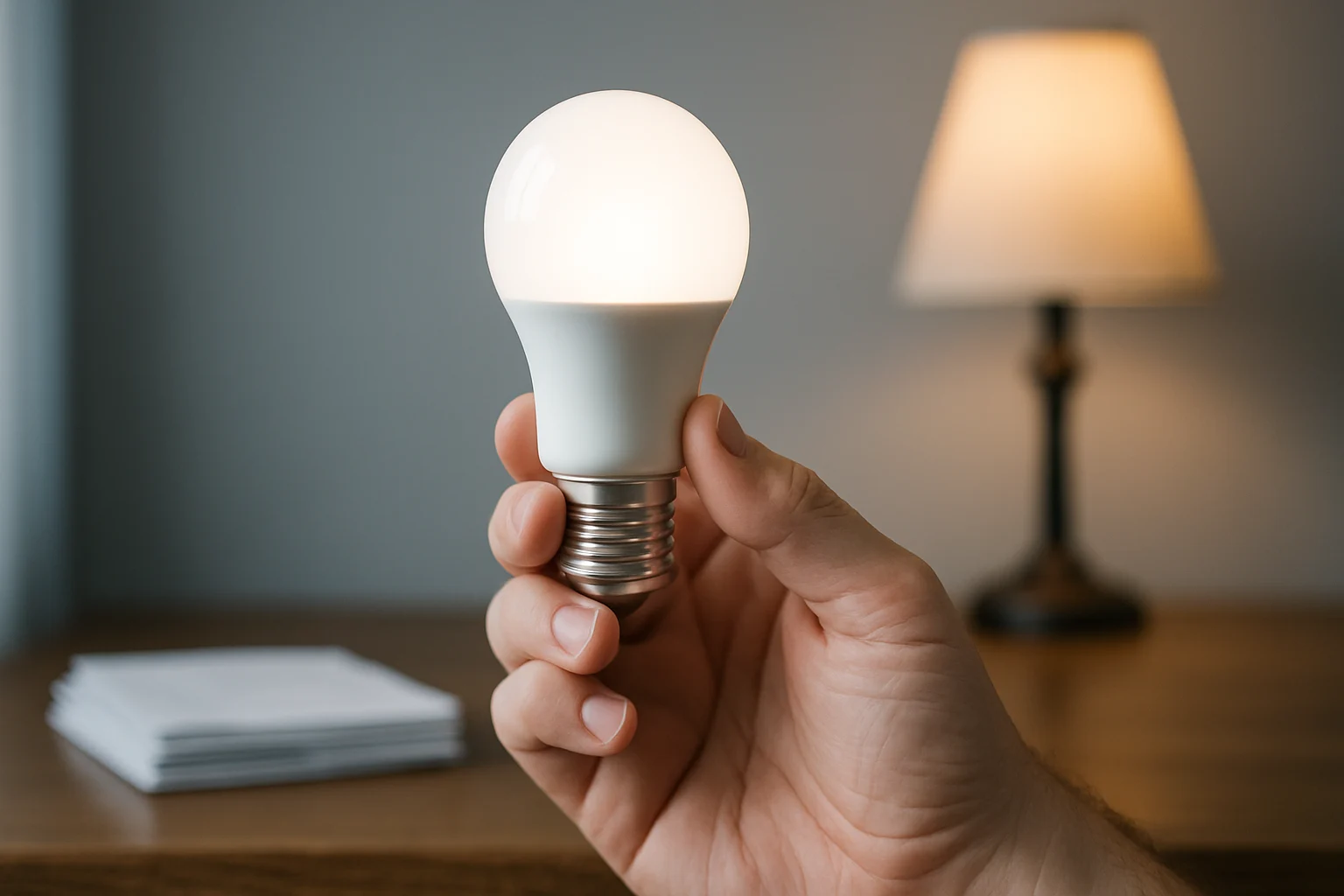
Want to save electricity bill this month? Start with three quick wins you can do today, then add low-cost upgrades with clear payback. Heating/cooling and water heating drive most usage; lighting and electronics add up. Below you’ll get a ranked plan with estimated $ and kWh savings, checklists, and when to consider bigger moves like insulation or a smart thermostat. Use the tracker to log your bill and results. Pick two habits today, add one upgrade next week—that’s it. For incentives you may qualify for, see our energy efficient home improvement credits guide.
Readers often ask how to lower your utility bill without renovations; this guide shows the order of operations.
Try the Interactive ToolQuick-start plan (typical home, $0.15/kWh):
- Set AC 78°F (heat 68°F) + fans: ~50–150 kWh/mo ($8–$23).
- Wash cold; air-dry half of loads: ~30–60 kWh/mo ($5–$9).
- Swap 10 bulbs to LED: ~65–90 kWh/mo ($10–$14).
- Kill standby with smart strips (TV/office): ~20–40 kWh/mo ($3–$6).
- Water heater 120°F: ~20–40 kWh/mo ($3–$6).
Total: ~185–380 kWh/mo ($29–$57).
These are practical energy saving tips for the home—straightforward energy saving tips for home most people can do today.
You’ll also get energy saving tips at home and compact home energy efficiency tips for renters.
Estimates are approximate and based on $0.15/kWh. Actual savings vary with home size, climate, equipment efficiency, and rate plan.
27 Frugal Tips That Actually Work
These practical ideas will help keep your electric bill lower without major spend or renovations.
If you’re wondering how to make your home energy efficient (or how to make a energy efficient home), start with air sealing and lighting.
This post contains affiliate links. If you buy through our links, we may earn a commission at no extra cost to you. Learn more.
- Set smart thermostat points: 78°F cooling / 68°F heating; nudge 1–2°F and use fans for comfort.
- Use ceiling fans correctly: Summer = counterclockwise breeze; winter = low/clockwise to gently recirculate warm air.
- Close blinds and curtains: Block midday summer sun; open south-facing in winter for passive heat.
- Cold-wash laundry: Modern detergents clean well in cold and cut water-heating load.
- Air-dry part of each load: Hang for 15–30 minutes, then finish in dryer to shorten cycles.
- Clean dryer lint every load: Better airflow = shorter dry times and lower kWh.
- Run dishwashers full: Use eco/air-dry settings; avoid heated dry.
- Turn lights off by habit: Build a door-switch routine for exits.
- Set device sleep to 10 minutes: Laptops/monitors save steadily while idle.
- Shorten showers: Trim 2 minutes to reduce hot-water energy.
- Set water heater to 120°F: Safe, efficient, and recommended by many utilities.
- Dial in fridge/freezer: 37–40°F fridge, 0–5°F freezer to avoid overcooling.
- Replace most-used bulbs with LEDs: Target kitchens, living rooms, and exteriors first.
- Use smart power strips: Kill standby draw on TV walls and home offices.
- Programmable/smart thermostat: Schedule set-backs and use geofencing.
- Low-flow showerheads (≈1.75 GPM): Comfortable feel with less hot water.
- Insulate hot-water pipes: First 6–10 feet off the heater matter most.
- Weatherstrip & door sweeps: Seal drafts around doors and attic hatches.
- Outlet/switch gaskets on exterior walls: Reduce wall-cavity leaks.
- Seal plumbing/attic penetrations: Foam or caulk gaps around pipes and wires.
- Install faucet aerators (1.0–1.5 GPM): Cut hot-water flow with minimal feel change.
- Clean fridge condenser coils: Annual vacuuming improves efficiency.
- Use dryer balls or a drying rack: Shorter dryer cycles, gentler on clothes.
- Add attic insulation where thin: Aim for your climate’s recommended R-value.
- Seal and balance ducts: Fix leaks to deliver conditioned air where it’s needed.
- Heat pump water heater (when replacing): Big kWh cuts vs. standard electric.
- Right-size to a high-efficiency heat pump (at replacement): Comfort + long-term savings.
Where Your Electricity Bill Goes (Biggest Uses)
If you’re wondering how to cut your utility costs overall, it helps to know where the energy goes.
Most homes spend the largest share on space heating and cooling, followed by water heating, then refrigeration, laundry, and electronics. If you want a quick primer on typical end-use shares, the U.S. Energy Information Administration has a clear overview with charts and definitions.
Know your rate plan: If you have time-of-use pricing, avoid peak windows and shift flexible loads to off-peak. On tiered plans, trimming usage late in the cycle can prevent you from spilling into a higher-priced tier. If your utility shows hourly data, look for spikes—electric dryers, ovens, and space heaters are common culprits.
Time-of-use habits deliver ways to save money on electric bill and broader ways to save money on power bill without new hardware.
Quick Wins to Save Electricity Bill (No-cost Habits That Save This Month)
For how to lower utility bills quickly, start with these simple habits you can do today.
- Thermostat discipline: 78°F in summer, 68°F in winter; use ceiling fans for comfort.
- Shift laundry and dishwashing to off-peak if you’re on time-of-use rates.
- Wash clothes in cold; clean dryer lint every load; air-dry when possible.
- Turn off lights when leaving rooms; set devices to auto-sleep after 10 minutes.
- Seal obvious drafts with door sweeps and temporary weatherstrip until you can do a full audit—see our DIY window insulation guide.
That one habit helps save electricity in summer by letting you raise the setpoint and still feel cool with a fan.
It also helps save electricity in winter by holding 68°F and sealing obvious drafts.
Kitchen & hot-water micro-wins: Set fridge to 37–40°F and freezer to 0–5°F; run dishwashers full and use air-dry; fix dripping hot-water faucets; take shorter showers.
How to save electricity at home in summer? Batch cold-wash laundry for cooler evenings and use air-dry.
Use the checklist if you’re asking how to save home electricity bill and want a clear starting point.
Among ways to lower utility bills, thermostat discipline ranks high and delivers how to reduce electricity bill at home results fast.
Not sure how to save the energy at home? Set devices to sleep so you how to save electricity in home with zero friction. Quick win: adjust setpoint and wrap pipes for an easy save electricity water heater improvement.
Low-Cost Upgrades to Save Electricity Bill Fast
- Swap remaining bulbs to LEDs; aim for 2700–3000K indoors for comfort.
- Smart power strips for TV, game consoles, and office gear to kill standby draw.
- Programmable or smart thermostat with scheduling and geofencing.
- Low-flow showerheads (1.75 GPM) and pipe insulation on the first 6–10 ft from the water heater.
- Gaskets for outlets/switches on exterior walls; foam around plumbing penetrations—use our spray foam insulation guide for larger gaps.
If you like diy energy efficiency, start with weatherstripping and outlet gaskets.
We’ve collected easy ways to save energy in your home you can knock out in under an hour.
Try diy home energy saving projects like pipe insulation and door sweeps this weekend.
Timers and smart strips cover how to save power in the home day to day; skip any so-called save electricity device.
These swaps measurably reduce electricity consumption home and target how to reduce electricity use at home.
They’re simple ways to reduce energy usage at home that steadily reduce energy use at home.

These upgrades are practical ways to save electricity in your home without buying extra hardware.
Prioritize for ROI: Replace the most-used bulbs first, add a smart thermostat if your schedule is irregular, and target standby in rooms with clusters of devices (TV wall or home office). Small, focused upgrades stack quickly.
Use this section as practical tips to reduce electricity bill at home when you plan weekend fixes.
Bigger Upgrades: When ROI Makes Sense
Consider attic insulation DIY top-ups, duct sealing & cleaning, heat pump water heaters, or a high-SEER heat pump when equipment is at end of life. Prioritize the envelope (air sealing and insulation) before sizing new HVAC; right-sizing prevents overspend and improves comfort.
Rule of thumb: If an upgrade pays back in ≤3 years and improves comfort/noise, it’s usually a yes. At 4–7 years, time it with equipment replacement. Longer than that, explore incentives before proceeding.
If you want ten ways to save energy at home, start with insulation, LEDs, smart strips, and thermostat tweaks.
Track Results: Log kWh, $ and Payback
Use your utility portal or a monthly spreadsheet to log kWh, average ambient temperature, and any changes you made. Compare like-for-like months year-over-year to see true savings and payback. If this page includes a tracker, enter last month’s bill, kWh, and the actions you completed.
Simple tracker recipe: Record bill date, kWh, average $/kWh, degree days (heating/cooling), and the actions you implemented. Revisit after 30 days and again against the same month last year to verify progress.
All of these help you save electricity home; lean on save electricity tips home that genuinely conserve electricity at home.
Prefer short lists—5 ways to save electricity, 6 ways to save electricity, 7 ways to save electricity or even 7 ways to save energy? Star the items you’ll actually do and review next month.
Your Best-Fit Savings Calculator
Estimate monthly savings from small changes. Adjust and see results instantly.
Estimated Monthly Savings
0 kWh (~$0.00)
Smart tweaks to HVAC, lighting, and standby cut wasted energy.
💡 Tip: Increase thermostat change or add a few LEDs for a bigger bump.
Calculator assumptions: ~35 kWh per °F thermostat change per month, ~7.5 kWh per LED bulb per month, and ~3 kWh per device on smart strips. Your savings vary by home size, climate, and rates.
Common question: will unplugging save electricity? Yes—especially for chargers and entertainment centers.
Related: does unplugging electronics save money and does unplugging electronics save electricity? Cutting standby draw helps with both.
Frequently Asked Questions
Conclusion
Start small, measure, iterate. Do two no-cost habits today, one low-cost upgrade this week, and use the calculator above to target your next 100 kWh. If you’re wondering how to save in electric bill month to month, keep logging results and refine your plan as seasons change.
This guide is educational and general in nature. Energy-cost estimates are illustrative and not guarantees of performance. For electrical, HVAC, or insulation work, consult a qualified, licensed professional and verify local codes and incentives.